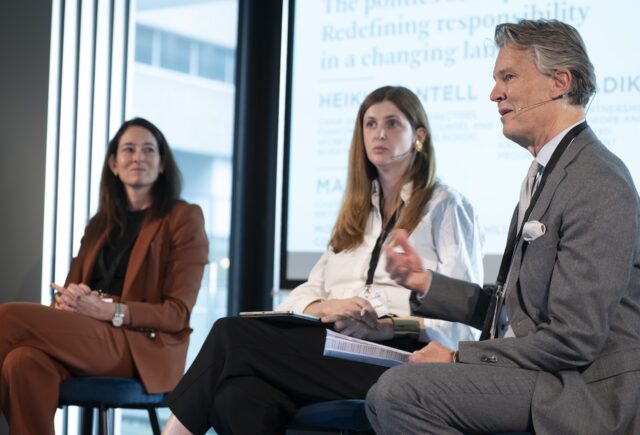Pension funds are setting aside money to invest in funds that make a positive social impact. But finding suitable investments and measuring impact still prove difficult.

At ABP, the champagne corks popped when the tender for the Noordzeker wind farm, off the coast of IJmuiden, was won. The Netherlands’ largest pension fund was able to show that it was serious about its plans not only to invest sustainably, but also to invest in projects that contribute to the energy transition.
“We want to have a positive impact on the energy security of the Netherlands in the future and therefore we signed in,” says Mart Keuning, responsible for sustainable and responsible investing at ABP. “In 2029, the windmill project we financed should supply 2.8 million households with energy”. The pension fund has reserved €30bn, out of total assets under management of around €474bn, for impact investments for the coming years. Of this, €10bn is to be invested in Dutch initiatives.
Finding enough destinations for this huge bag of money turns out not to be so easy. Except for the billions for Noordzeker – the 40-year concession alone cost €40m, without as much as a pillar on the bottom of the sea – ABP has so far mainly financed real estate projects. For example, with Bouwinvest, €400m has been invested in affordable, sustainable rental housing. “In the near future, we are going to shout very loudly from the rooftops that we have money. But impact projects have to meet specific conditions and certainly generate sufficient returns.”
Biodiversity
It is already a big step for ABP and other pension funds such as PME and PFZW that they have included social impact in addition to risk, return and costs as the fourth criterion for their investments. But they also want to be able to measure the effect of such an impact investment. And that’s still a work in progress.
“For us, it’s not so much about how many wind turbines are built, but how much CO2 emissions are avoided as a result,” explains Cedric Scholl of asset manager APG Asset Management. “ABP and we are therefore looking for suitable indicators.” For CO2 emissions, these already exist, but for a relatively new topic like biodiversity, it is different. Pending the availability of suitable measuring instruments, external expertise from the Naturalis Biodiversity Center, for example, is being relied on.
For now, Keuning and Scholl are looking only at unlisted initiatives. “You can say that a Tesla share is a very sustainable share. For us, that is not an impact investment because it makes no measurable difference,” says Keuning. His investor eye focuses mainly on projects in infrastructure and energy supply. Startups and scale-ups can go to another ABP counter, such as the energy transition and biodiversity fund ANEB.
There is a big gap between what pension funds want and what they actually do, believes Willem Schramade, professor of finance at Nyenrode Business University. “Pension funds are still largely [invested] in government bonds and harmful companies, and very little in assets that make a positive impact.”
Why? The main reason, according to Schramade, is that impact investing requires a different way of thinking. “They are still trapped in the efficient market thinking of strict return expectations and extreme diversification, both by region and sector.”
Certainty
The 4Impact capital fund could be a suitable candidate for ABP and APG. The fund selects software companies that could make a difference when it comes to climate change and social issues. “We started in 2018 but pension funds are not on board yet,” says co-founder and fund manager Ali Najafbagy. He is looking for about €100m for his second fund, but experiences that it is still too small for players like ABP.
Najafbagy sees another bottleneck. Pension investors, he says, want certainty that the companies deliver what they promise and ask for a track record. That is still a problem for relatively young companies and impact funds.
International asset manager Axa also notes that their clients want to know how companies intend to realise the positive impact. “It’s about impact as well as financial performance,” says head of listed impact stocks, Anna Väänänen. She selects large companies because many SMEs cannot keep their heads above water in turbulent economic times.
Venture funds
“There is more than enough suitable supply,” believes Wendy de Jong, president of regional development company Oost-NL. “Regional development companies like ours, together with InvestNL, can play the role of connecting link perfectly well. We know the activity in the region like no other.”
She cites the example of making all 3,800 business sites in the Netherlands more sustainable. “If you put such a project in one basket, the scale problem of an ABP is over. There are so many circular business initiatives that need funding for scaling up, from electrification of the transport sector to plastic reuse in the chemical sector.”
Having worked in the pensions sector herself, De Jong sees the problem mainly in the way pension investors approach impact investing. “Pension administrators view impact investments as venture funds for startups and high-growth companies or private equity funds. They are high risk and so high returns must follow suit.” Their view needs to change, she believes. “It’s less risky because the market is moving in that direction.”
Research from insurer NN from 2019 confirms what De Jong said. Companies that pursue a positive impact grow faster and have lower capital costs than competitors without that profile. This is not a surprise, the insurer wrote at the time. “These companies tend to be more innovative and do not usually operate in declining industries. All this makes them less cyclical.”
It is mainly a matter of getting used to it, she thinks. “We have to learn to understand each other. We could take some of the risk away from the pension funds and take it on ourselves to help them cross the threshold. I also think pension funds still shy away from the relatively high development costs of a business case that meets their criteria. At 3%, that fee is now about one percentage point higher than normal, and that does come at the expense of a bit of return.”
Swiss army knife
The name of state investment fund Invest-NL is a constant in the conversations. It is supposed to be the middleman between the money of the pension funds and socially relevant initiatives. Chairman of the board of directors of Invest-NL Rinke Zonneveld also notes: “We are seen as a kind of Swiss army knife.”
He is optimistic about the possibilities, even though he has been talking to major Dutch pension funds about the subject for a year. “Their desire to invest more in the Netherlands is genuine. They come from a world of profit maximisation and now have to weigh things differently. The road from policy to implementation is quite a long one.”
In consultations, described by Zonneveld as “exploratory conversations”, structures that can help pension funds are being considered. “Denmark and Belgium, for example, have a fund that invests in “various early growth funds”. That has sufficient scale for large pension funds. We are also thinking of periodically organising finance roundtables with family offices, venture capital and pension funds, for example on topics such as energy storage and biofuels.”
Zonneveld hopes to present something in September and is in the process of freeing up funds to build a structure to mobilise pension money and other patient capital.
One concern for the pension funds is the political headwind that has risen. Part of the Dutch coalition [government] does not like the sustainable route because it may come at the expense of returns. Thierry Aartsen, a member of parliament for the centre-right VVD party, filed a motion in May about whether politicians could force pension funds to look only at returns.
Professor Schramade is annoyed by the suggestion that sustainable investments come at the expense of returns. “That is really nonsense, sustainable investments do not have different risk-return ratios. Moreover, the cost of doing nothing now is many times greater when we are later faced with the consequences of global warming.”
This article originally appeared in Dutch business newspaper FD on 25 August 2024.





